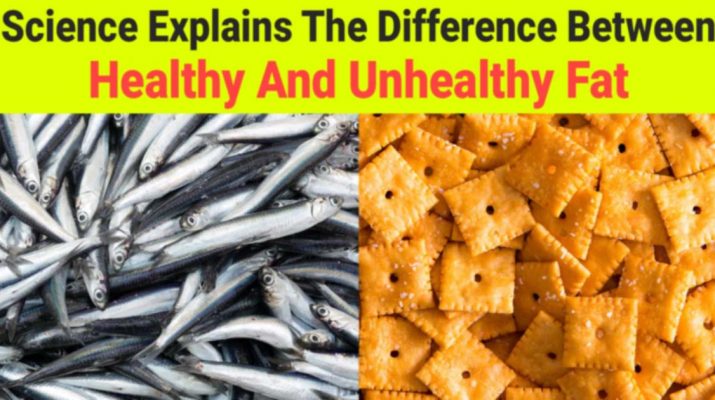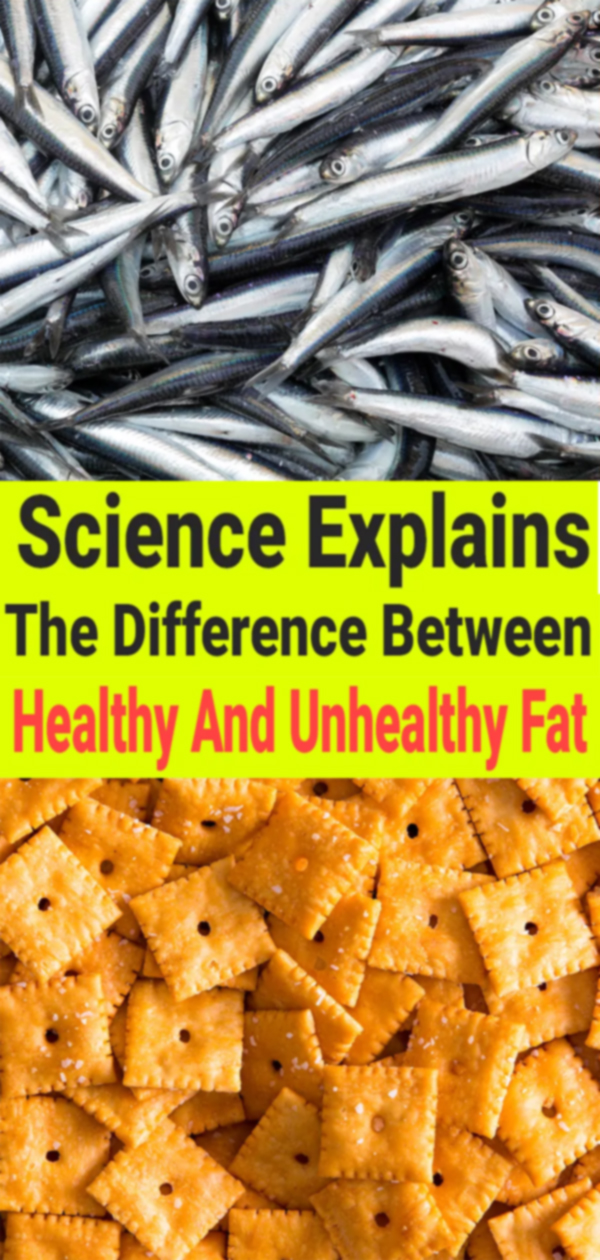Fat is one of the three crucial macronutrients that the body requires, but it also gets a bad reputation. People believe that fat can be responsible for weight gain, heart disease, and countless chronic and degenerative illnesses.
But the secret lies in the health value of the fats that you eat. There’s more to fat than just pizza and fried foods. In fact, there are as many as four different kinds of fats, all of which carry different levels of healthiness.
How does this work? Well, each type of fat has a different carbon structure – varying in length, chain size, and bonds. This is what determines how these fats react to situations like cooking and consumption, as well as how they affect the body when we eat them.
To better understand what fats to enjoy and which ones to avoid, you need to know a bit about each of these four fats, how to tell them apart, and why they’re different. Here’s how science explains the difference between healthy and unhealthy fat.
Science Explains The Difference Between Healthy And Unhealthy Fat
1. Healthy Fat: Monounsaturated Fatty Acids
Monounsaturated fatty acids, also known simply as MUFAs, are a kind of fat that the body is capable of making on its own. These fatty acids respond to the consumption of carbohydrates, becoming synthesized in the liver as you digest these components. Of course, you can also get MUFAs from plenty of foods, including:
- Olive oil
- Avocados
- Cashews
- Almonds
- Pistachios
- Pecans
- Peanuts
- Sunflower seeds
- Pumpkin seeds
- Pork
- Eggs
Most MUFAs – and the best ones! – are plant-based, and they contain oleic acid as the main ingredient. Some also may contain palmitoleic acid or vaccenic acid instead. A large majority of MUFAs are liquid in state at room temperature, and they have a double bond as an unsaturated type of fat. MUFAs provide the body with countless benefits to the health, including the following:
A) Insulin Sensitivity
Insulin is a type of neurotransmitter responsible for blood glucose control. This hormone helps balance sugar levels within the blood, moving it from blood to cells as needed. Well-functioning insulin can prevent blood sugar problems that can lead to diabetes.
The problem comes when insulin loses its sensitivity, meaning it cannot accurately detect blood glucose levels. MUFAs may be able to help in this scenario, improving overall insulin sensitivity by as much as 9% within three months.
B) Weight Loss
It’s common knowledge that fat contains more calories than proteins and carbohydrates, at 9 calories/gram against 4 calories/gram. This is why lowering fat consumption works so well in helping weight loss.
With that being said, MUFAs can actually aid weight loss when consumed in moderation, according to a diet plan that ensures a calorie deficit. Research suggests that those who eat diets high in these fats provide the same weight loss effects as low-fat diets and much better weight loss results than high-carb ones.
C) Heart Disease
Many people believe that fats are responsible for heart disease. While not entirely false, the issue is, as always, that it’s not fats on their own; it’s too much fat consumption that leads to this problem.
As a matter of fact, eating moderate amounts of MUFAs – and likely increasing the overall consumption of them in your diet – may help to reduce and have positive effects on cholesterol and bad fat levels overall. One of the biggest reasons behind heart disease is bad cholesterol, which clogs arteries. MUFAs, however, provide good cholesterol.
Research suggests that high consumption of MUFAs within an appropriately proportioned diet without saturated fats can bring bad cholesterol levels down by an impressive five percent. Plus, MUFAs can lower blood pressure, even in those with metabolic syndrome and diabetes, which further reduces heart disease risk.
D) Inflammation
Chronic, long-term inflammation is often a catalyst for heart disease, obesity, heart conditions, and virtually all other common life-threatening and chronic conditions. Diets high in MUFA are able to bring down inflammation and reduce it significantly.
This is likely why Mediterranean diets – which are rich in MUFAs like fish, nuts, and olive oil – have had such a remarkable effect on lowering multiple disease rates in the region.
E) Cancer
Some studies draw links between MUFAs and a reduced risk in prostate cancer and breast cancer through the protective powers of one of its components. However, these studies were observational and more research is needed to draw conclusions.
2. Healthy Fat: Polyunsaturated Fatty Acids
Polyunsaturated fatty acids, also known simply as PUFAs, are a kind of fat with multiple double bonds, found in both plant and animal sources. The body does not create them on its own, and as such, they are considered essential nutrients.
Polyunsaturated fats are mainly omega-3 and omega-6 fatty acids. They oxidize upon air exposure, and as such become spoiled more quickly than monounsaturated fats. You can get PUFAs from plenty of foods, including:
- Herring
- Sardines
- Salmon
- Bass
- Trout
- Shrimp
- Soybean oil
- Flaxseed oil
- Safflower oil
- Sunflower oil
- Grapeseed oil
- Poppyseed oil
While too much PUFAs can cause health complications like inflammation, digestive issues, and weight gain, consuming moderate and healthy amounts of PUFAs is surprisingly good for you. Here are some of them.
A) Heart Health
As we know, heart health has been falsely correlated with any kind of fat consumption for years, when it’s actually linked to excessive fat more than anything else. In fact, PUFAs, especially omega-3 fatty acids, actually provide positive benefits to heart health.
Research indicates that eating fatty fish regularly can greatly decrease the chances of death through heart disease and related conditions. The same connection has been found with any kind of omega-3 PUFA as well, though this does not extend to omega-3 supplements.
B) Mental Strength
DHA, which is a PUFA and an omega-3 fatty acid, is extremely useful in promoting better brain function and development. Age-related cognitive degeneration is less likely in those who eat a lot of DHA, reducing the risks of dementia and Alzheimer’s disease.
Some research indicates that DHA helps adults regulate mood and positive thinking, and many more studies show that it can boost memory, concentration, and productivity. Do note that omega-3 supplements have not been found to provide these results.
C) Child Development
Studies have largely suggested that expecting mothers and breastfeeding mothers who eat between 8 and 12 ounces of fatty fish on a weekly basis (or eat this fish over two times in a week) wind up with healthier kids.
Links were drawn because children whose mothers have met those requirements have higher visual motor abilities and language skills, and they are also less likely to develop communication, behavioral, and fine motor problems.
Do note that this does not work with omega-3 supplements and that pregnant and breastfeeding parents need to be careful in order not to consume too much mercury from fish. As such, they need to select their choice of fish carefully.
3. Average-Health Fat: Saturated Fat
Saturated fat has a carbon structure with no double bond, as their carbon atoms are completely surrounded by hydrogen. They have earned a negative reputation that, while not entirely unfounded, is still not completely true.
The bad background that saturated fat has today is rooted in a heart disease epidemic that broke out in the 20th century in the US. From being a rare condition, the disease suddenly became the main cause of fatalities, a title which it still has to this day.
Researchers scrambled to find an answer for why this was happening, and they soon discovered that saturated fat and high cholesterol seem to be linked. Since high cholesterol leads to heart disease, many drew the conclusion that this fat bore responsibility for the rise of this condition.
However, this research was never actually tested on any humans. It went on to become public policy without being proven correct. Today, modern research suggests that this research is inaccurate, and there are actually zero links between saturated fat and heart disease.
Unfortunately, the demonization these fats have endured have led to a lack of positive thinking that can’t be undone easily. While they’re not as healthy as monounsaturated or polyunsaturated fats, they’re still worth adding to your plate occasionally.
Here Are Some Sources Of Unsaturated Fat:
- Cream
- Butter
- Chicken
- Cheese
- Dark chocolate
- Coconut oil
- Palm oil
- Processed meats (unhealthy)
- Cake and other grain-based desserts (unhealthy)
But, you say, what about cholesterol? Well, saturated fat has a balanced effect on both good and bad cholesterol – or, specifically, the lipoproteins that transport cholesterol, HDL (known as healthy lipoprotein) and LDL (known as the less healthy lipoprotein).
Saturated fat raises the levels of LDL, which is why people avoid saturated fat like the plague. But, actually, there are different types of LDL – a small type that increases heart disease risk, and a large type that cannot get into the arteries at all and is basically benign.
Saturated fat consumption has proven to be able to change small LDL to large, benign LDL – which can actually play a small role in reducing overall heart disease risk. On top of that, saturated fat also raises good HDL in the body, too, so it’s actually a positive thing to add to your diet.
4. Unhealthy Fat: Trans Fat
Trans fats are the worst types of fats out there. They are largely man-made and are characterized by a double bond with opposite hydrogen atoms. While they keep for long periods of time without spoiling, are typically cheap, and taste good, trans fats can be very harmful to the body. Trans fats are responsible for:
- Increased risk of heart diseases, diabetes, and chronic illness
- Worsened inflammation
- Higher chance of cancer development
- Obesity risk
In fact, the increase in trans fat consumption throughout America is very closely correlated to heart disease cases increasing throughout the nation. Some foods you might want to avoid are:
-
- Pizza
- Crackers
- Vegetable shortening
- Fried foods
- Vegetable oil
- Cookies
- Condiments and spreads
- Margarine
- Junk food
- Microwavable popcorn
However, note that some natural trans fats from animals have not proven dangerous. As such, fats from non-processed meats from sheep, cows, and goats are safe to consume.
Final Thoughts On The Difference Between Healthy And Unhealthy Fat
With all the information and misinformation about fats out there, it is easy to make the mistake of writing them all off as bad – even though some of them can give you amazing benefits! Knowing the difference between healthy and unhealthy fats will help you pick the right ones to add to your diet.


